Mitigation of High-Frequency Eddy Current Losses in Hairpin Winding Machines
Abstract
:1. Introduction
2. Winding Simulation at Strand Level
2.1. Types of Eddy Current Losses
2.2. Baseline Machine
2.3. Two-Slot Model at Strand Level
2.4. Mitigation of Eddy Current Losses in Hairpin Windings
- (i)
- Reducing the conductor height (). However, this method can result in a reduced fill factor and an increased DC resistance component;
- (ii)
- Reducing the external flux density (). This is can be done be leaving a space near the slot opening, so that the upper conductors are less affected by the cross-slot leakage flux. However, using this method will result in a lower coil height, and eventually a lower fill factor;
- (ii)
- Increasing the material resistivity () can also be an effective method to reduce the high-frequency eddy current losses. However, this requires the use of a different conducting material than pure copper, with higher resistivity.
2.5. Aluminum as an Alternative to Copper at High Frequency
3. Experimental Verification
4. Conclusions
Author Contributions
Funding
Conflicts of Interest
Appendix A
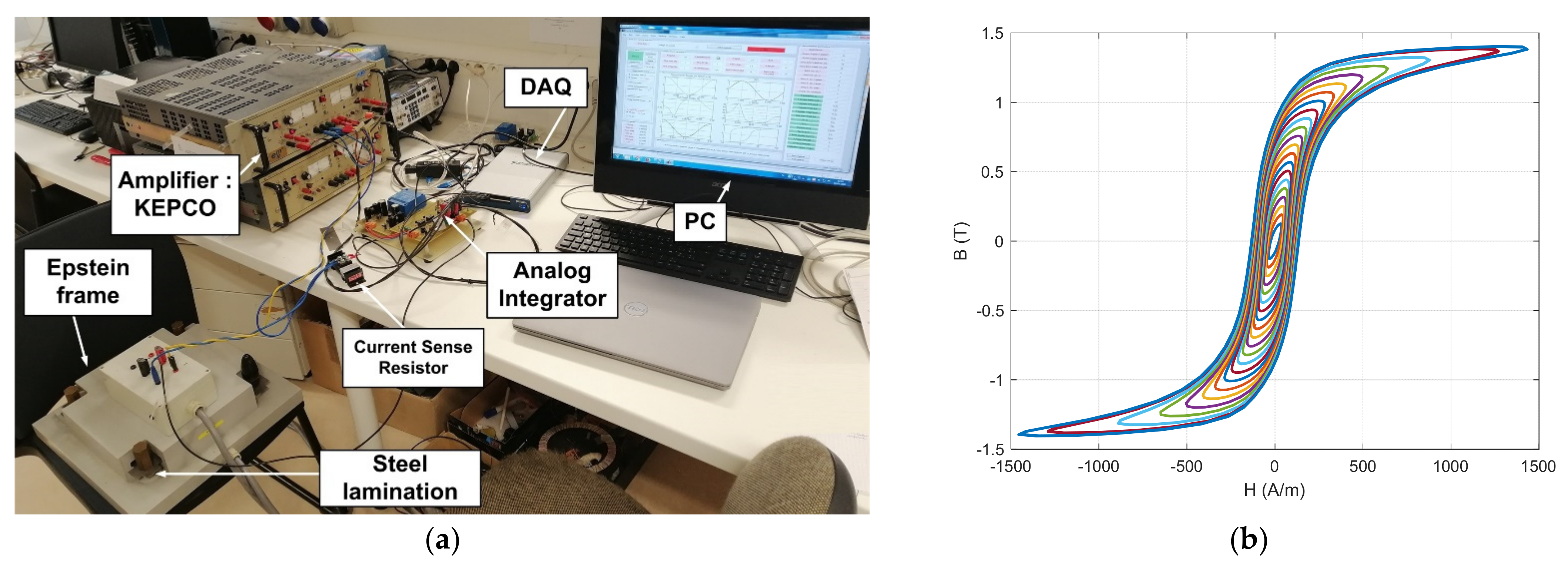
References
- Volpe, G.; Popescu, M.; Marignetti, F.; Goss, J. AC Winding Losses in Automotive Traction E-Machines: A New Hybrid Calculation Method. In Proceedings of the 2019 IEEE International Electric Machines & Drives Conference (IEMDC), San Diego, CA, USA, 12–15 May 2019; pp. 2115–2119. [Google Scholar]
- Selema, A.; Ibrahim, M.N.; Sprangers, R.; Sergeant, P. Effect of Using Different Types of Magnet Wires on the AC Losses of Electrical Machine Windings. In Proceedings of the 2021 IEEE International Electric Machines & Drives Conference (IEMDC), Online, 17–20 May 2021; pp. 1–5. [Google Scholar]
- Silber, S.; Wex, B.; Kaspar, K. Efficient Method for Simulation of AC Losses in Permanent Magnet Synchronous Machines. In Proceedings of the 2020 10th International Electric Drives Production Conference (EDPC), Online, 8–9 December 2020; pp. 1–5. [Google Scholar]
- Zhao, Y.; Li, D.; Pei, T.; Qu, R. Overview of the rectangular wire windings AC electrical machine. CES Trans. Electr. Mach. Syst. 2019, 3, 160–169. [Google Scholar] [CrossRef]
- Selema, A.; Ibrahim, M.N.; Sergeant, P. Metal Additive Manufacturing for Electrical Machines: Technology Review and Latest Advancements. Energies 2022, 15, 1076. [Google Scholar] [CrossRef]
- Bardalai, A.; Zhang, X.; Zou, T.; Gerada, D.; Li, J.; Gerada, C. Comparative Analysis of AC losses with round magnet wire and Litz wire winding of a High-Speed PM Machine. In Proceedings of the 2019 22nd International Conference on Electrical Machines and Systems (ICEMS), Harbin, China, 11–14 August 2019; pp. 1–5. [Google Scholar]
- Selema, A. Development of a Three-Phase Dual-Rotor Magnetless Flux Switching Generator for Low Power Wind Turbines. IEEE Trans. Energy Convers. 2020, 35, 828–836. [Google Scholar] [CrossRef]
- Bardalai, A.; Gerada, D.; Golovanov, D.; Xu, Z.; Zhang, X.; Li, J.; Zhang, H.; Gerada, C. Reduction of Winding AC Losses by Accurate Conductor Placement in High Frequency Electrical Machines. IEEE Trans. Ind. Appl. 2020, 56, 183–193. [Google Scholar] [CrossRef]
- Du, G.; Ye, W.; Zhang, Y.; Wang, L.; Pu, T.; Huang, N. Comprehensive Analysis of the AC Copper Loss for High Speed PM Machine With Form-Wound Windings. IEEE Access 2022, 10, 9036–9047. [Google Scholar] [CrossRef]
- Artetxe, G.; Prieto, B.; Caballero, D.; Elosegui, I.; Martinez Maza, G. A Practical Approach for Estimating Bundle-Level Proximity Losses in AC Machines. IEEE Trans. Ind. Electron. 2021, 1. [Google Scholar] [CrossRef]
- Selema, A.S.; Osheba, D.S.; El-Shanawany, M.M.; Tahoun, S.M. Design and Analysis of a Brushless Three Phase Flux Switching Generator for Aircraft Auxiliary Power Unit. In Proceedings of the 2018 Twentieth International Middle East Power Systems Conference (MEPCON), Cairo, Egypt, 18–20 December 2018; pp. 198–202. [Google Scholar] [CrossRef]
- Xiao, T.; Li, J.; Yang, K.; Lai, J.; Lu, Y. Study on AC Copper Losses in an Air-Cored Axial Flux Permanent Magnet Electrical Machine with Flat Wires. IEEE Trans. Ind. Electron. 2022, 1. [Google Scholar] [CrossRef]
- Tawfiq, K.B.; Selema, A.; Ibrahim, M.N.; Sergeant, P. Synchronous Reluctance Motor Drive System Fed From Three-Phase Matrix Converter. In Proceedings of the 2021 IEEE Industrial Electronics and Applications Conference (IEACon), Online, 22–23 November 2021; pp. 79–84. [Google Scholar]
- Iwasaki, S.; Deodhar, R.P.; Liu, Y.; Pride, A.; Zhu, Z.Q.; Bremner, J.J. Influence of PWM on the Proximity Loss in Permanent-Magnet Brushless AC Machines. IEEE Trans. Ind. Appl. 2009, 45, 1359–1367. [Google Scholar] [CrossRef] [Green Version]
- Moreno, Y.; Almandoz, G.; Egea, A.; Arribas, B.U.A. Analysis of Permanent Magnet Motors in High Frequency—A Review. Appl. Sci. 2021, 11, 6334. [Google Scholar] [CrossRef]
- Evspecifications 2019 Nissan Leaf Specification. Available online: https://www.evspecifications.com/en/model/2bc417 (accessed on 8 April 2022).
- Sullivan, C.R. Computationally efficient winding loss calculation with multiple windings, arbitrary waveforms, and two-dimensional or three-dimensional field geometry. IEEE Trans. Power Electron. 2001, 16, 142–150. [Google Scholar] [CrossRef] [Green Version]
- Mellor, P.; Wrobel, R.; Simpson, N. AC losses in high frequency electrical machine windings formed from large section conductors. In Proceedings of the 2014 IEEE Energy Conversion Congress and Exposition (ECCE), Pittsburg, PA, USA, 14–18 September 2014; pp. 5563–5570. [Google Scholar]
- OHMITE TAP2000—Ultra High Power Planar Resistor. Available online: https://www.ohmite.com/assets/docs/res_tap2k.pdf?r=false (accessed on 8 April 2022).




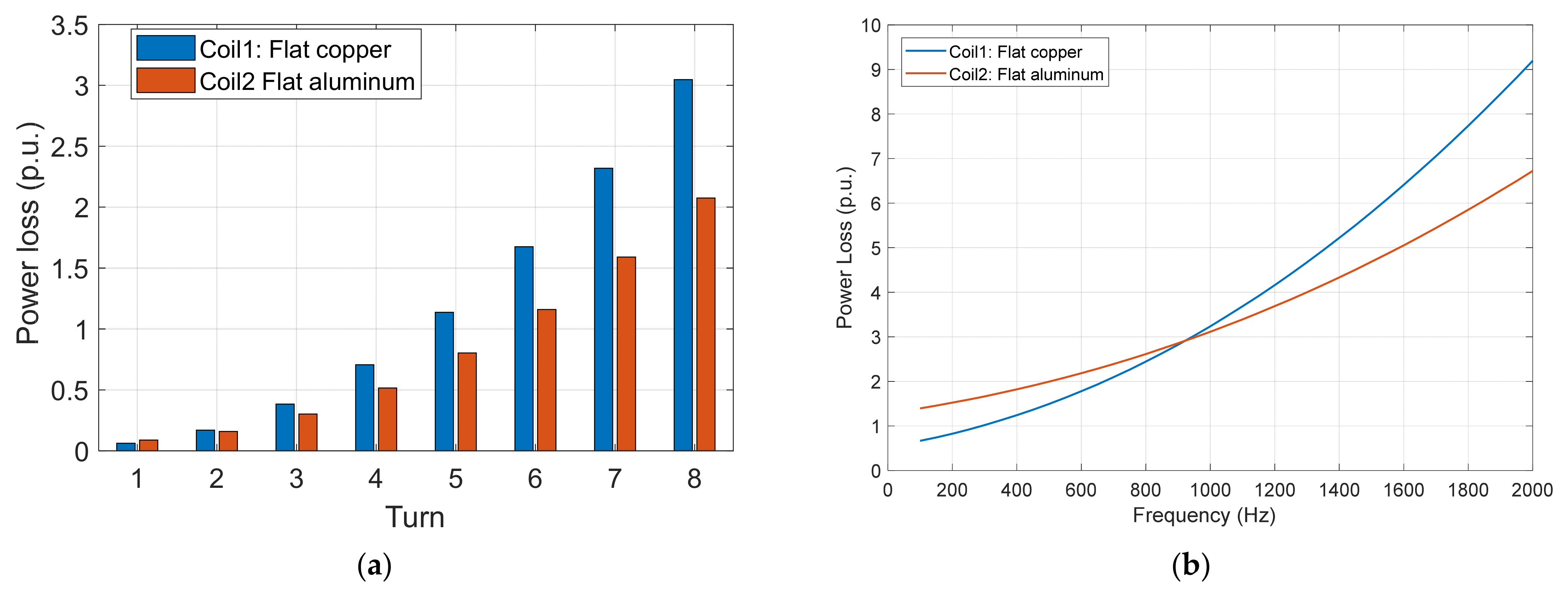
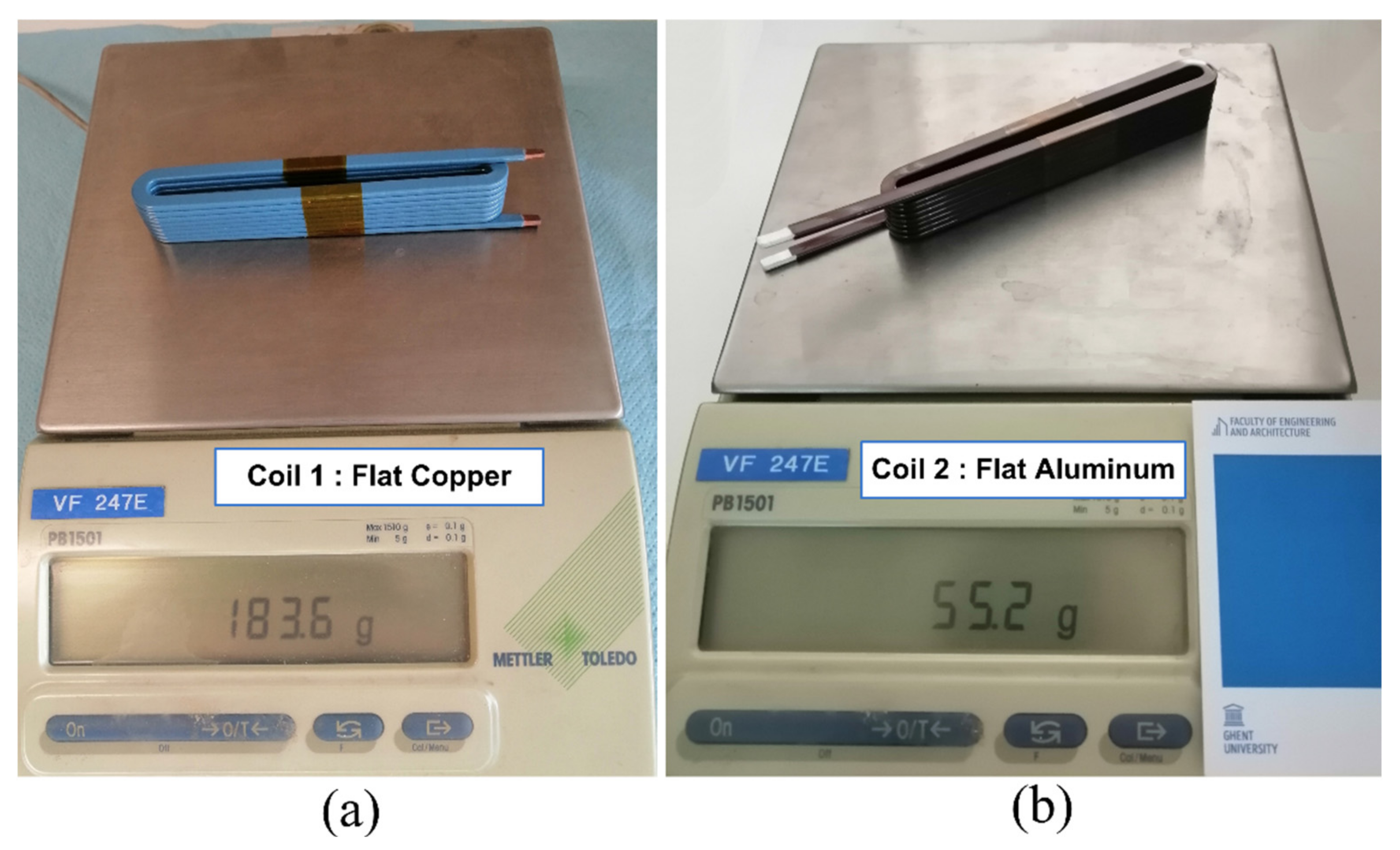
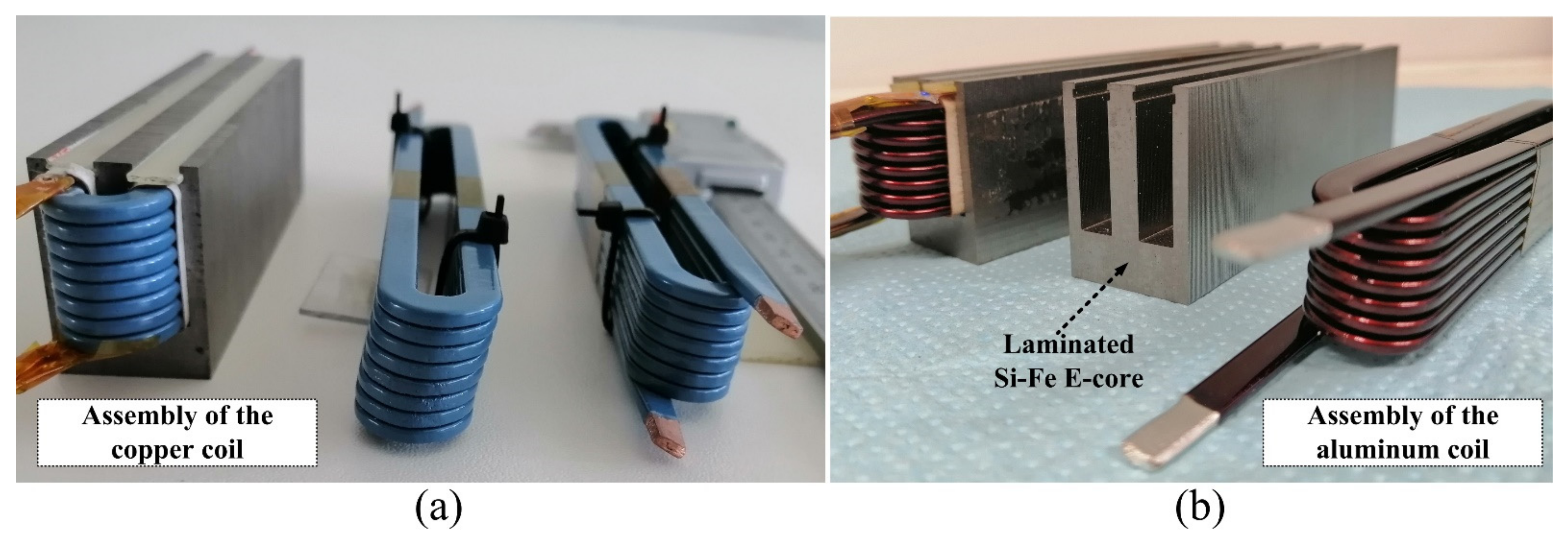



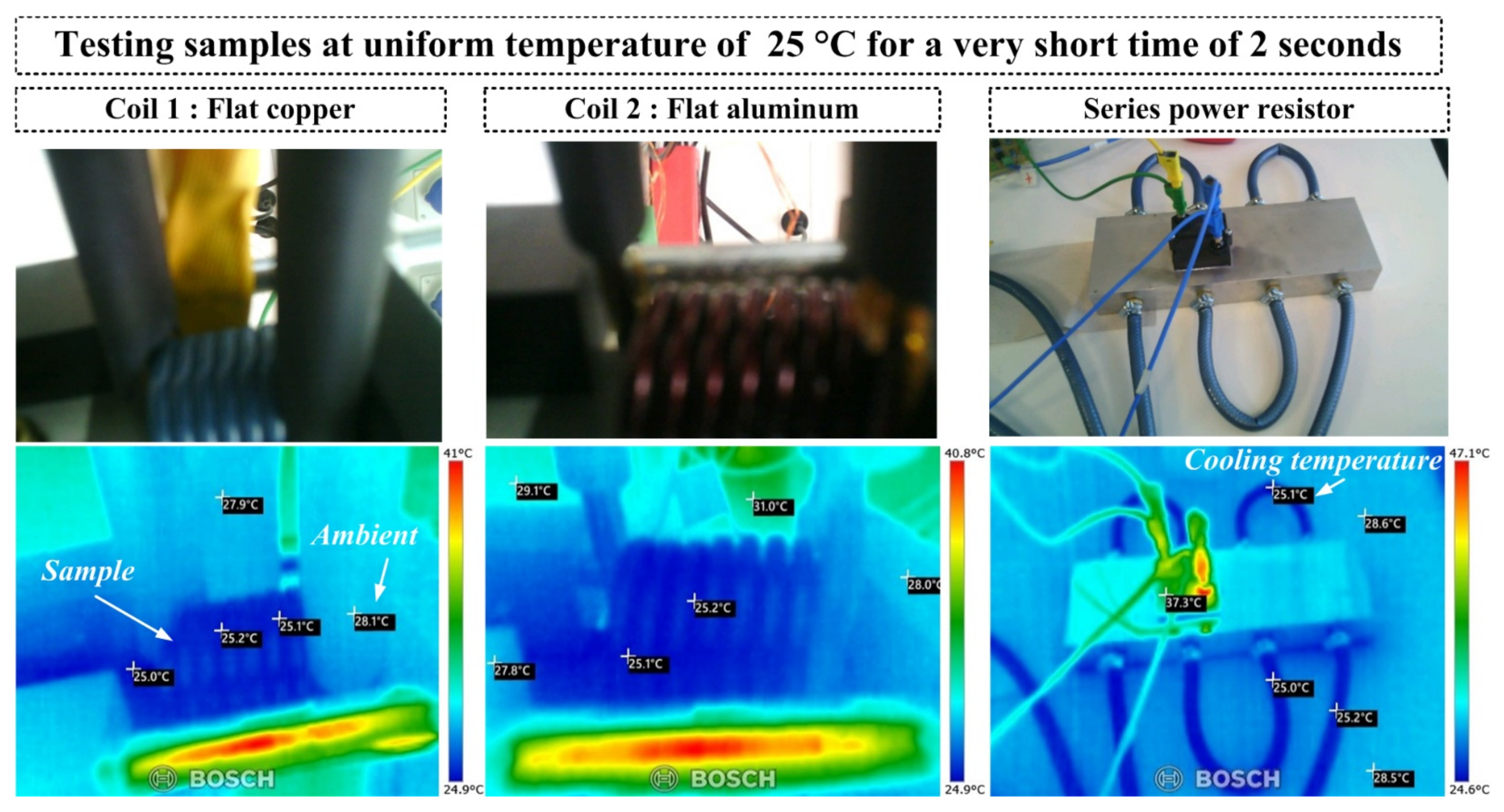

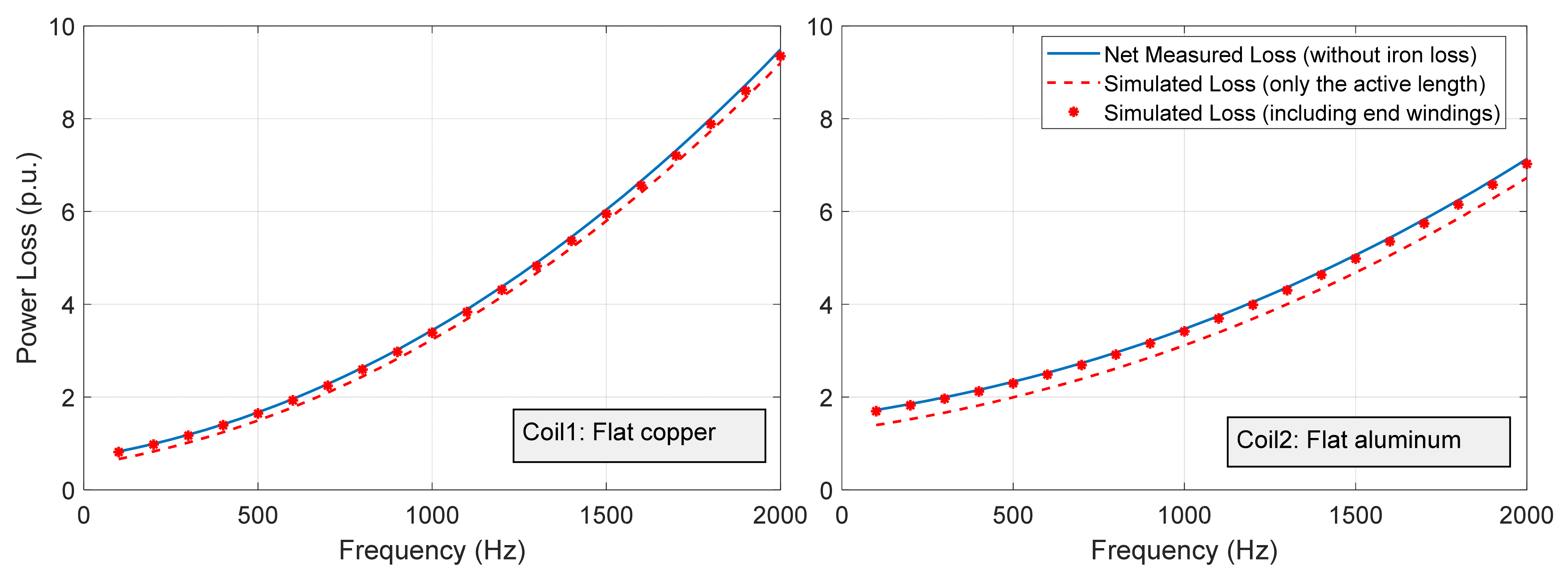

| Coil 1 | Coil 2 | |
|---|---|---|
| Type | Flat copper | Flat aluminum |
| Mass density | 8.96 gm/cm3 | 2.7 g/cm3 |
| Coil Weight | 183.6 gm | 55.2 gm |
| Fill factor | 72.6% | 72.6% |
| Resistance Temper. Coeff. | 0.00393 /K | 0.00410 /K |
| Total losses @ 2 kHz | 12.1 p.u. | 9.77 p.u. |
| Loss ratio (AC to DC) @ 2 kHz | 14 | 4.79 |
| Preferable frequency range | Up to 1 kHz | Above 1 kHz |
Publisher’s Note: MDPI stays neutral with regard to jurisdictional claims in published maps and institutional affiliations. |
© 2022 by the authors. Licensee MDPI, Basel, Switzerland. This article is an open access article distributed under the terms and conditions of the Creative Commons Attribution (CC BY) license (https://creativecommons.org/licenses/by/4.0/).
Share and Cite
Selema, A.; Ibrahim, M.N.; Sergeant, P. Mitigation of High-Frequency Eddy Current Losses in Hairpin Winding Machines. Machines 2022, 10, 328. https://doi.org/10.3390/machines10050328
Selema A, Ibrahim MN, Sergeant P. Mitigation of High-Frequency Eddy Current Losses in Hairpin Winding Machines. Machines. 2022; 10(5):328. https://doi.org/10.3390/machines10050328
Chicago/Turabian StyleSelema, Ahmed, Mohamed N. Ibrahim, and Peter Sergeant. 2022. "Mitigation of High-Frequency Eddy Current Losses in Hairpin Winding Machines" Machines 10, no. 5: 328. https://doi.org/10.3390/machines10050328








